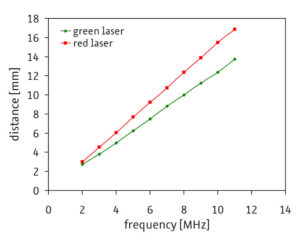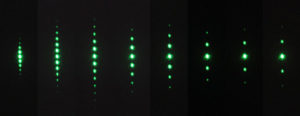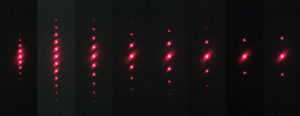Debye-Sears Effect
Diffraction of light by a standing ultrasonic wave (Debye-Sears effect) in a liquid
The experiment shows the diffraction of light by a standing ultrasonic wave (Debye-Sears effect) in a liquid. The speed of sound in the liquid (water) is determined by the dependence of the diffraction maxima on the wavelength of the diffracted laser light and the frequency of the ultrasonic wave.
Keywords: Debye-Sears effect, diffraction of light, diffraction grating, diffraction maxima, wavelength, speed of sound, standing and traveling wave
In 1932, Debye and Sears showed that light is diffracted when it passes through a liquid that is excited to high-frequency vibrations. This effect can be used to make ultrasound "visible". The density maxima and minima generated in the liquid by a standing or moving ultrasound wave act like an optical diffraction grating. The grating constant of such a grating generated by an ultrasound wave corresponds to the wavelength of this ultrasound wave. It can be determined using the diffraction patterns of the light from a laser beam of known wavelength. Since the wavelength is defined by frequency and the speed of sound, the Debye-Sears effect can be used in this experimental setup to determine the speed of sound in the liquid through which the sound passes (e.g. water) with high accuracy.
The figures below show typical diffraction patterns for green and red laser light on a standing ultrasound wave in water at sound frequencies from 3 MHz to 10 MHz (step size: 1 MHz). As the ultrasound frequency increases, the distances between the individual diffraction maxima increase, with the longer-wave red laser light being diffracted more strongly. The number of diffraction orders is essentially determined by the transmission properties of the sound probe and the frequency-dependent attenuation.

Distance of the diffraction maxima depending on the sound frequency

Diffraction patterns of green lasers

Diffraction patterns of red lasers
SCOPE OF DELIVERY:
ADDITIONAL EXPERIMENTS:






